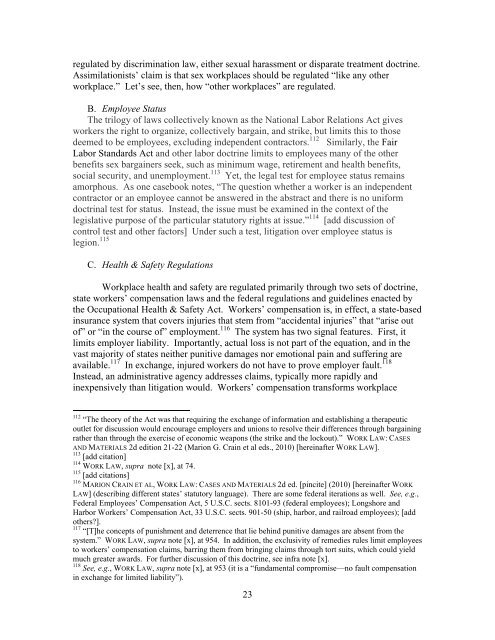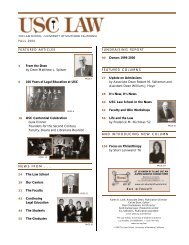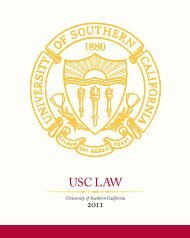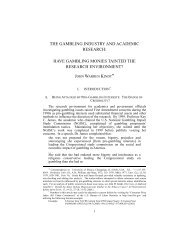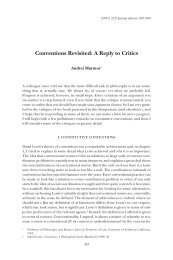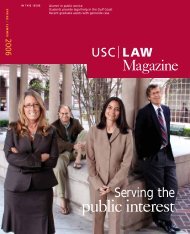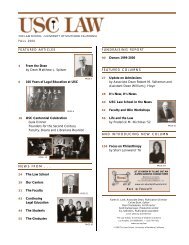1 Regulating Sex Work Adrienne D. Davis VERY ROUGH DRAFT ...
1 Regulating Sex Work Adrienne D. Davis VERY ROUGH DRAFT ...
1 Regulating Sex Work Adrienne D. Davis VERY ROUGH DRAFT ...
You also want an ePaper? Increase the reach of your titles
YUMPU automatically turns print PDFs into web optimized ePapers that Google loves.
egulated by discrimination law, either sexual harassment or disparate treatment doctrine.<br />
Assimilationists’ claim is that sex workplaces should be regulated “like any other<br />
workplace.” Let’s see, then, how “other workplaces” are regulated.<br />
B. Employee Status<br />
The trilogy of laws collectively known as the National Labor Relations Act gives<br />
workers the right to organize, collectively bargain, and strike, but limits this to those<br />
deemed to be employees, excluding independent contractors. 112 Similarly, the Fair<br />
Labor Standards Act and other labor doctrine limits to employees many of the other<br />
benefits sex bargainers seek, such as minimum wage, retirement and health benefits,<br />
social security, and unemployment. 113 Yet, the legal test for employee status remains<br />
amorphous. As one casebook notes, “The question whether a worker is an independent<br />
contractor or an employee cannot be answered in the abstract and there is no uniform<br />
doctrinal test for status. Instead, the issue must be examined in the context of the<br />
legislative purpose of the particular statutory rights at issue.” 114 [add discussion of<br />
control test and other factors] Under such a test, litigation over employee status is<br />
legion. 115<br />
C. Health & Safety Regulations<br />
<strong>Work</strong>place health and safety are regulated primarily through two sets of doctrine,<br />
state workers’ compensation laws and the federal regulations and guidelines enacted by<br />
the Occupational Health & Safety Act. <strong>Work</strong>ers’ compensation is, in effect, a state-based<br />
insurance system that covers injuries that stem from “accidental injuries” that “arise out<br />
of” or “in the course of” employment. 116 The system has two signal features. First, it<br />
limits employer liability. Importantly, actual loss is not part of the equation, and in the<br />
vast majority of states neither punitive damages nor emotional pain and suffering are<br />
available. 117 In exchange, injured workers do not have to prove employer fault. 118<br />
Instead, an administrative agency addresses claims, typically more rapidly and<br />
inexpensively than litigation would. <strong>Work</strong>ers’ compensation transforms workplace<br />
112<br />
“The theory of the Act was that requiring the exchange of information and establishing a therapeutic<br />
outlet for discussion would encourage employers and unions to resolve their differences through bargaining<br />
rather than through the exercise of economic weapons (the strike and the lockout).” WORK LAW: CASES<br />
AND MATERIALS 2d edition 21-22 (Marion G. Crain et al eds., 2010) [hereinafter WORK LAW].<br />
113<br />
[add citation]<br />
114<br />
WORK LAW, supra note [x], at 74.<br />
115<br />
[add citations]<br />
116<br />
MARION CRAIN ET AL, WORK LAW: CASES AND MATERIALS 2d ed. [pincite] (2010) [hereinafter WORK<br />
LAW] (describing different states’ statutory language). There are some federal iterations as well. See, e.g.,<br />
Federal Employees’ Compensation Act, 5 U.S.C. sects. 8101-93 (federal employees); Longshore and<br />
Harbor <strong>Work</strong>ers’ Compensation Act, 33 U.S.C. sects. 901-50 (ship, harbor, and railroad employees); [add<br />
others?].<br />
117<br />
“[T]he concepts of punishment and deterrence that lie behind punitive damages are absent from the<br />
system.” WORK LAW, supra note [x], at 954. In addition, the exclusivity of remedies rules limit employees<br />
to workers’ compensation claims, barring them from bringing claims through tort suits, which could yield<br />
much greater awards. For further discussion of this doctrine, see infra note [x].<br />
118<br />
See, e.g., WORK LAW, supra note [x], at 953 (it is a “fundamental compromise—no fault compensation<br />
in exchange for limited liability”).<br />
23


